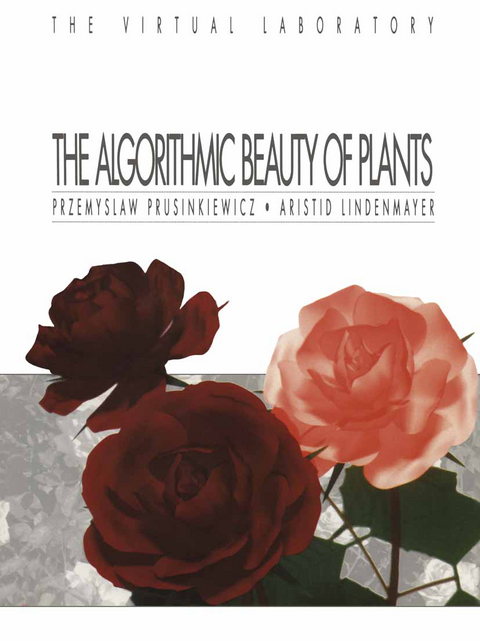
The Algorithmic Beauty of Plants
Springer-Verlag New York Inc.
978-0-387-94676-4 (ISBN)
The beauty of plants has attracted the attention of mathematicians for Mathematics centuries. Conspicuous geometric features such as the bilateral sym and beauty metry of leaves, the rotational symmetry of flowers, and the helical arrangements of scales in pine cones have been studied most exten sively. This focus is reflected in a quotation from Weyl [159, page 3], "Beauty is bound up with symmetry. " This book explores two other factors that organize plant structures and therefore contribute to their beauty. The first is the elegance and relative simplicity of developmental algorithms, that is, the rules which describe plant development in time. The second is self-similarity, char acterized by Mandelbrot [95, page 34] as follows: When each piece of a shape is geometrically similar to the whole, both the shape and the cascade that generate it are called self-similar. This corresponds with the biological phenomenon described by Herman, Lindenmayer and Rozenberg [61]: In many growthprocesses of living organisms, especially of plants, regularly repeated appearances of certain multicel lular structures are readily noticeable. . . . In the case of a compound leaf, for instance, some of the lobes (or leaflets), which are parts of a leaf at an advanced stage, have the same shape as the whole leaf has at an earlier stage. Thus, self-similarity in plants is a result of developmental processes. Growth and By emphasizing the relationship between growth and form, this book form follows a long tradition in biology.
1 Graphical modeling using L-systems.- 1.1 Rewriting systems.- 1.2 DOL-systems.- 1.3 Turtle interpretation of strings.- 1.4 Synthesis of DOL-systems.- 1.5 Modeling in three dimensions.- 1.6 Branching structures.- 1.7 Stochastic L-systems.- 1.8 Context-sensitive L-systems.- 1.9 Growth functions.- 2 Modeling of trees.- 3 Developmental models of herbaceous plants.- 3.1 Levels of model specification.- 3.2 Branching patterns.- 3.3 Models of inflorescences.- 4 Phyllotaxis.- 4.1 The planar model.- 4.2 The cylindrical model.- 5 Models of plant organs.- 5.1 Predefined surfaces.- 5.2 Developmental surface models.- 5.3 Models of compound leaves.- 6 Animation of plant development.- 6.1 Timed DOL-systems.- 6.2 Selection of growth functions.- 7 Modeling of cellular layers.- 7.1 Map L-systems.- 7.2 Graphical interpretation of maps.- 7.3 Microsorium linguaeforme.- 7.4 Dryopteris thelypteris.- 7.5 Modeling spherical cell layers.- 7.6 Modeling 3D cellular structures.- 8 Fractal properties of plants.- 8.1 Symmetry and self-similarity.- 8.2 Plant models and iterated function systems.- Epilogue.- Appendix A Software environment for plant modeling.- A.1 A virtual laboratory in botany.- A.2 List of laboratory programs.- Appendix B About the figures.- Turtle interpretation of symbols.
"This marvelous book will occupy an important place in the scientific literature." --Prof. Heinz-Otto Peitgen, author of The Beauty of Fractals "...will perform a valuable service by popularizing this enlightening and bewitching form of mathematics." --Steven Levy "...full of delights and an excellent introduction to L-systems" --Alvy Ray Smith, IEEE Graphics and its Applications
| Erscheint lt. Verlag | 27.3.1996 |
|---|---|
| Reihe/Serie | The Virtual Laboratory |
| Mitarbeit |
Assistent: J.S. Hanan, F.D. Fracchia, D.R. Fowler |
| Zusatzinfo | 14 Illustrations, black and white; XII, 228 p. 14 illus. |
| Verlagsort | New York, NY |
| Sprache | englisch |
| Maße | 210 x 280 mm |
| Themenwelt | Informatik ► Grafik / Design ► Digitale Bildverarbeitung |
| Mathematik / Informatik ► Informatik ► Theorie / Studium | |
| Mathematik / Informatik ► Mathematik | |
| Naturwissenschaften ► Biologie ► Botanik | |
| ISBN-10 | 0-387-94676-4 / 0387946764 |
| ISBN-13 | 978-0-387-94676-4 / 9780387946764 |
| Zustand | Neuware |
| Informationen gemäß Produktsicherheitsverordnung (GPSR) | |
| Haben Sie eine Frage zum Produkt? |
aus dem Bereich


